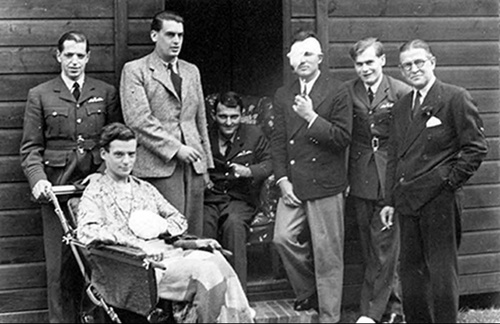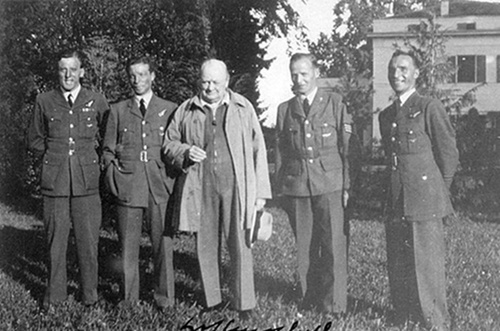Auction: 22003 - Orders, Decorations and Medals
Lot: 497
'I lay back exhausted.
An hour later the matron re-entered, followed by a young man, who looked to be in his late thirties. Having introduced him as Mr. McIndoe, she departed. The visitor had dark hair parted in the middle and brushed flat to the head, horn-rimmed spectacles, broad shoulders and a friendly mischievous grin. His whole appearance was not unlike that of Harold Lloyd, the film comedian.
Grasping a leather briefcase firmly inside a hand that would have done credit to a professional boxer, he advanced round to the left hand side of the patient's bed and seated himself on an upright chair. Extracting a sheet of paper and pencil he viewed me over the top of his glasses. The eyes had an incredible depth behind them and seemed to exude great understanding. The words came out crisply with the slight flatness of note peculiar to New Zealanders.
"Hurricane or Spitfire?"
"Hurricane."
"Header tank?"
I laughed. "Yes. The wing tanks in my machine were self-sealing, but some bright type forgot to treat the tank in front of the pilot."
The eyes twinkled again. "Just can't trust anyone, can you?"
We both laughed.
He didn't stay long and during his short visit the conversation was light-hearted and dealt with seemingly inconsequential details. Was I wearing goggles and gloves? How long was I in the water, and how soon afterwards was the tannic acid treatment given?
The visitor rose and said a cheery farewell to me. He waved a large ham-fisted hand as he rose passed rapidly through the door. "Good-bye, young fellow. See you again."
Little did I realize how often I would be seeing him … '
Wing Commander Geoffrey Page, D.S.O., O.B.E., D.F.C., describes his first encounter with Sir Archibald McIndoe, to whom he remained eternally grateful. Page returned to active service after two years of plastic surgery and 15 major operations, vowing to shoot down an enemy aircraft for each of them, a target duly achieved.
The important Freedom of the City of London parchment certificate awarded to the New Zealand born pioneering plastic surgeon Sir A. H. "Archie" McIndoe C.B.E., F.R.C.S., who greatly improved the treatment and rehabilitation of badly burned R.A.F. aircrew and other servicemen during the Second World War and who, with the willing support of his patients, formed the famous 'Guinea Pig Club'
Freedom of the City of London parchment certificate, named to 'Sir Archibald Hector McIndoe, Kt., C.B.E., Citizen and Pattenmaker of London' in the Mayoralty of 'Sir Denis Henry Truscott, Kt., T.D.' dated 19 March 1958, contained in its red card envelope inscribed Copy of Freedom - City of London, together with 'Rules for the Conduct of Life', a booklet which accompanied the Freedom of the City, in very good condition
Archibald Hector McIndoe was born in Dunedin on 4 May 1900, the son of John McIndoe, founder of a successful printing firm, and of Mabel, née Hill, well known in her own right as singer and artist, and sister of Alfred Hill, a composer and musician.
Educated at the Otago Boys' High School, and the University of Otago, after graduation he held a house surgeon appointment at the Waikato Hospital in Hamilton and then secured the first fellowship at the Mayo Clinic granted to New Zealand.
In 1930, McIndoe moved to London and came under the influence of a relative, also a New Zealander, Sir Harold Gillies, who was at that time creating the new speciality of plastic surgery at St. Bartholomew's Hospital. McIndoe became his assistant at St. Bartholomew's and joined him in partnership in private practice as a plastic surgeon.
In 1938 McIndore was appointed a consultant in plastic surgery to the Royal Air Force and on the outbreak of war he became surgeon in charge of the now famous plastic and jaw injury centre at the Queen Victoria Hospital, East Grinstead.
The Guinea Pig Club
An excellent summary of McIndoe's wartime achievements appears in an article by Jacquie Pinney and Antony D. Metcalfe, as published in the PMTA Journal (Volume 1, Issue 2, December 2014):
'At the outbreak of World War Two there were only four fully experienced plastic surgeons in Britain: Gillies, McIndoe, Rainsford Mowlem and T. P. Kilner. At the request of the government they were divided up to head up four separate plastic surgery units to treat the expected influx of injured servicemen from the different branches of the armed services. Sir Archibald moved to the recently rebuilt Queen Victoria Hospital in East Grinstead, and founded a centre for plastic and jaw surgery, dealing with Royal Air Force casualties.
As airborne warfare began it became clear that this was the stark new chapter in medical treatment. The Queen Victoria Hospital in East Grinstead was to treat casualties at an unparalleled volume and severity of injury. The phrase 'airman's burn' quickly became a medical term referring to the common similarities of injuries sustained to the face and hands. These injuries were mostly caused when aircraft fuel tanks ignited and pilots were caught up in the inferno before they could parachute to safety. Most pilots removed their gloves and goggles during flying in order to aid control of the aircraft but unfortunately this also exposed them to even greater levels of injury.
It was also clear to Archibald that current burns treatment techniques were inadequate, particularly the use of Tannic Acid and Tannic Jelly which when applied shrank the tissue around a burn to reduce fluid loss. However, this tightening of the tissue of hands and face caused far more problems than benefits. McIndoe responded to this by devising new ways to treat burns including use of saline to bathe them and forced the Ministry of Health to ban Tannic Acid treatments. He also evolved previous plastic surgery techniques to become far more effective in restoring wounded skin and tissue. His vision for treatment was far reaching and summed up in an early comment that he made whilst trying to treat burns. He said: "When it is realised that a third degree burn produces a raw surface for which the best dressing is skin itself applied at the earliest possible moment, we shall have come nearest to reconciling treatment with function."
An extraordinary club: the Guinea Pig Club
Not only did McIndoe advance technical innovation but also developed strategies for rehabilitation and reintegration of burns survivors back into society. In 1941 an unusual club was formed at the Queen Victoria Hospital - the Guinea Pig Club, whose members consisted of his recovering patients.
The club committee was carefully selected; Sir Archibald (affectionately known as 'the boss' or 'the maestro') was the first president. The Guinea Pigs' sense of humour is evident in the club's constitution: the first secretary had severely damaged fingers encouraging minimal minute taking, while the severely damaged legs of the first treasurer made him unlikely to 'walk off' with club funds. To become a Guinea Pig, members had to be aircrew and have undergone two surgeries performed by McIndoe.
Most of the club would be made up of British pilots or bomber crewmen. However, a number of Guinea Pigs were Canadian, Australian, New Zealanders, American and East European. As the numbers of casualties grew, McIndoe increased the numbers of people in his surgical team at East Grinstead. A key addition to the team in January 1942 was Canadian plastic surgeon, Dr Ross Tilley, who helped McIndoe with his pioneering techniques.
McIndoe's 'boys' were allowed to wear their own service uniforms whilst recovering and a supply of beer was always on tap in the form of the barrel kept in the ward. The formation of the club was a key part of rehabilitation, using camaraderie and the shared experiences of the men to help support each other during their lengthy and painful rehabilitation.
For some members of the club their disfigured features were too much for their wives and girlfriends to cope with and their pre-war relationships ended at a most traumatic time. However, a number of them ended up marrying nurses from the hospital as they got used to seeing past their injuries. The people of Britain were indebted to all personnel from the armed services for their valiant efforts during World War Two, and the Guinea Pigs met and talked of their experiences to many people, including Sir Winston Churchill.
Psychological support was also needed when the Guinea Pigs left the protection of the hospital ward and re-entered society to face the general public, whose responses were often not kind when seeing their disfigurements. Visits up to London were often accompanied by horrified onlookers and comments about not letting them out in public.
McIndoe then put out a request that hospital staff and the welfare committee should spread the word that any injured airman in town must not be made to feel uncomfortable and be regarded as "normal young men who happen to be in temporary difficulty." The people of East Grinstead thus became a key part of McIndoe's vision and were fundamental in the rehabilitation process. The people of East Grinstead and the warmth and acceptance that they showed to the Guinea Pigs were quite rightly given the accolade of 'the town that didn't stare'.
Fortunately, many people showed extraordinary kindness to the Guinea Pigs, particularly Neville and Elaine Blond who opened up their substantial house for them to stay in whilst recovering and turned a blind eye to the racket and mischief cause by the rabble of 'Pigs'.
By the end of the war, members of the Guinea Pig Club totalled 649, testament to the incredible efforts of Archibald McIndoe. Many of the Guinea Pigs managed to reintegrate into society and find work through their determination and confidence, which was drawn from the other members.
The Guinea Pigs continued to meet annually to celebrate Archibald McIndoe and the club. For many years the Guinea Pig pub in East Grinstead was a focal point for summer reunions, followed by a black-tie dinner and toasts made to 'the Queen', 'absent friends' and 'the women', completed with a rendition of the Guinea Pig anthem. Against the odds many have lived into old age.'
McIndoe was created a C.B.E. in 1944 and a Knight Bachelor in 1947, in addition to receiving an equally deserved haul of foreign honours, among them Commander of the Legion of Honour (France), Order of the White Lion (Czechoslovakia), Officer of the Order of Polonia Restituta (Poland) and Commander of the Order of Nassau (Holland).
He died suddenly on 12 April 1960, aged just 59, and is the only civilian to have had his ashes interred at St. Clements Danes 'the R.A.F. Church' in London.
The Duke of Edinburgh was greatly honoured by an invitation to take his place as President of the Guinea Pig Club and his pioneering work at Queen Victoria Hospital continues to this day, under the auspices of the Blond McIndoe Research Foundation.
Sold with two related books: Faces from the Fire. The Biography of Sir Archibald McIndoe by Leonard Mosley, 269 pp. hardback; and The Guinea Pig Club by Edward Bishop. 125 pp. softback.
Subject to 20% VAT on Buyer’s Premium. For more information please view Terms and Conditions for Buyers.
Sold for
£320
Starting price
£180











